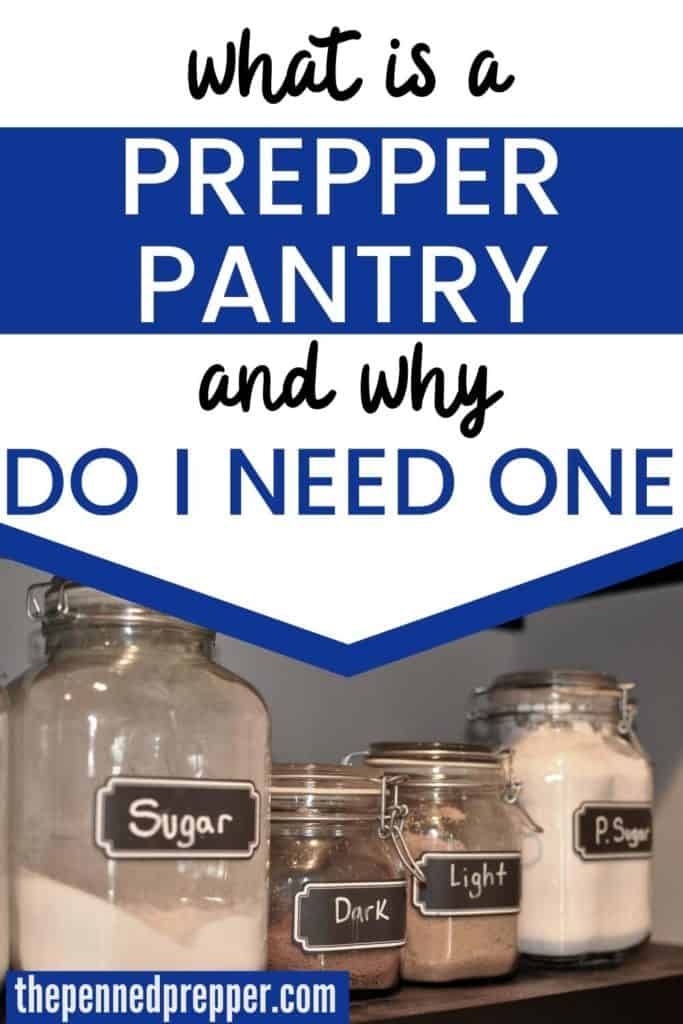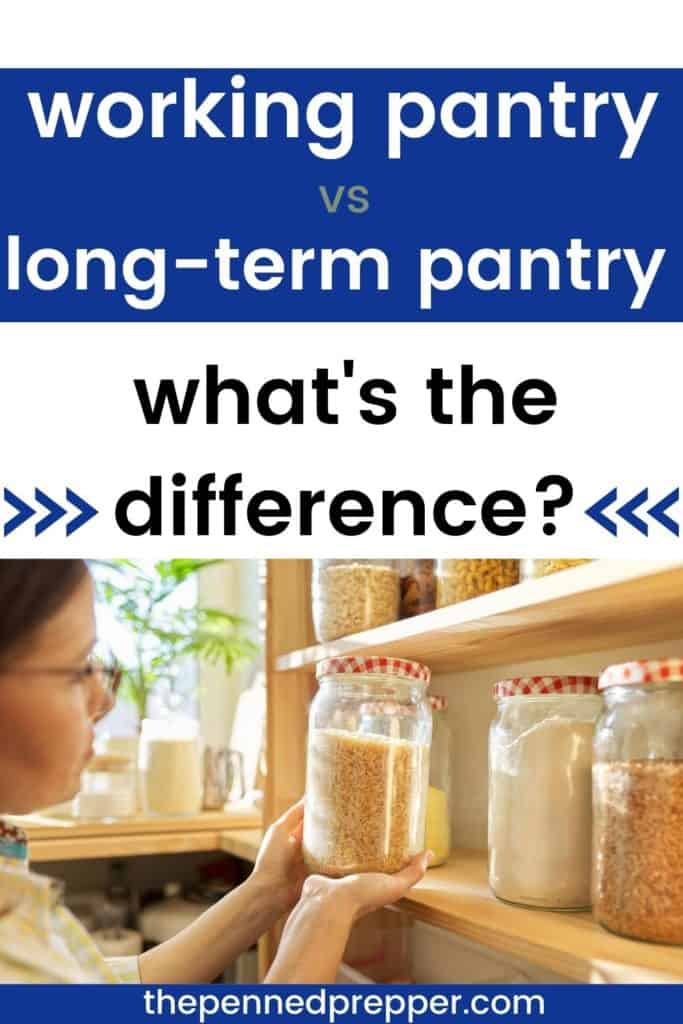What Is A Prepper Pantry and Why Should You Consider Starting One?
Easy Navigation
What is a Prepper Pantry
Prepper pantries are the backbone of the prepper life. A prepper pantry is basically your normal kitchen pantry, except it is better thought out and designed to last long-term. In the case of a survival situation (such as those spurred on by a natural disaster or some devastating social/economical event), your prepper pantry is the place where you store all the food you need to survive the situation as normally as possible.
These survival foods would include shelf-stable that can be stored for long periods of time.
Items such as:
- Dry beans
- Canned beans
- Rice
- Peanut butter
- Honey
- Cooking oils (such as olive oil or coconut oil)
- Items for baking (flour, sugar, baking powder, baking soda, etc – just make sure it is in a container for long-term storage)
- Canned foods and goods
- Dehydrated foods
- Freeze-dried foods
Basically anything with a long shelf life. Having all of these types of emergency foods stored up can help you through several different types of emergencies.

As an Amazon Associate I earn from qualifying purchases. This page may contain affiliate links from various companies, which means if you click on a link and make a purchase, I might make a little bit of money, at no extra cost to you. For more information please visit our disclosure policy
Who Can Benefit From Building a Prepper Pantry?
Absolutely anyone can benefit from creating their very own prepper pantry. You never know what could happen; and if you live in a particularly high risk or turbulent area, you will definitely not regret stockpiling food in a prepper emergency pantry.
Take the Pandemic of 2020 for example. When everybody made a rush on the stores and bought out all the perishable (and non-perishable) foods, what was left for shoppers and consumers to buy? Whether you saw the pictures online or the empty store shelves in person, unless you have been living under a rock, you are well aware that every store in every city was out of just about everything – and it took months to get things back to normal and for stores to stop rationing food. (Some stores still are rationing food!)
And experts say we will see this happen again at the end of the year. Every prepper and non-prepper needs to take note and be prepared so that their loved ones do not go hungry.
Prepper pantries are perfect for anyone that wants to be prepared to get themselves and their family through a potential catastrophe. Large families with multiple children or eldery family members should especially consider prepping a pantry. You will want to make sure any dietary restrictions are met, food allergies will need to be addressed as well as having foods any picky little ones will eat enough of. (I know my toddlers tend to go through annoying phases of only eating graham crackers and apple sauce for weeks on end – hopefully I’m not the only one!)
It is always a good idea to stock up on non-perishable foods that are also enjoyed by you and your family. It is not necessary to only prepare with MREs and bland calories. Stockpile foods that are delicious and enjoyable, but that still have a long shelf life. You can be creative with your shopping, as long as you make sure to have the supplies needing to prepare the food items you choose!
When Will You Need a Prepper’s Pantry?
What constitutes an emergency situation and when will your food supply come in handy? Unfortunately, for most situations, you won’t know you need a pantry filled with food storage until it’s already too late to go to the grocery store and stock up on food. Thus the term “Be Prepared.” But if you have taken the time to set up a prepper’s pantry before you needed it, you and your family will be so grateful that you didn’t wait until the need was upon you.
Just a few examples of emergency situations in which a pantry filled with emergency food will come in handy include:
- Power outage (short-term or long-term)
- Tornados
- Blizzards
- Hurricanes
- Pandemic/lockdown
- Evacuation due to fire, etc
- Rioting/’peaceful protests’ (ha!)
- Famine
- Supply chain or manufacturing issues
- Plant and animal diseases
- Unexpected job loss
- SHTF situations
- Other natural disasters

The Difference Between A Working Pantry and A Long-Term Emergency Pantry
Now that I’ve got you on the path to knowing you need a prepper’s pantry, I need to point out that there are actually two main types of prepper pantries. Each has their place and you are welcome to consider choosing one, the other, or both, without going wrong. Your available space and resources will determine which of these two types of pantries will be best for your situation.
The first type or style of pantry is what’s called a “working” pantry, and the second is known as a “long term” pantry. Both of these pantries have their own pros and cons, so it is important to know which one works best for you as you begin to gather supplies and consider what you are preparing for.
What is a Working Pantry?
A working pantry is a style of pantry you can use even if there is not an emergency going on. The working pantry is perfect for daily use. However, unlike a typical kitchen pantry, a prepper’s working pantry includes a whole lot more than just a couple of days’ worth of food and supplies.
Instead of just one jar of peanut butter or baking powder like a normal pantry, you would have enough for maybe a month. (Or however much you have the space for.) In fact, you will want to set (and meet) the goal of eventually having a month’s worth of absolutely everything in your working pantry.
For this kind of pantry it is incredibly important to follow the rule of FIFO— “first in, first out.” Keep your oldest items (according to expiration date) in the front and restock from the back to avoid spoilage. Can roller shelves (such as these from Amazon) are particularly handy for this style of pantry.

What are the Pros of a Working Pantry?
A working pantry is the easiest to start. All you need is a little patience and commitment to building up your month’s worth of food storage. A working pantry is also very inexpensive to get going. You can either plan on buying two of everything you need every time you shop and only consuming one before you go shopping again, or if you are a couponer or a sale-shopper, you can stock up on things while they are on sale. In fact, I know many families (mine included) who utilize a working pantry for the sheer fact that it is a grocery budget saver.
A working pantry is a very customizable style of pantry and is really perfect for the beginning prepper to get started with. Even the newest prepper can get their feet wet by learning to keep track of how much their household uses up in a given period of time (something every prepper should know). You can try it out with some basics first and expand or experiment with other things as time goes by. As you get more comfortable with it, you can even try making batches your own shelf-stable foods with a dehydrator or a canner.
What are the Cons of a Working Pantry?
A working pantry is not usually conducive to a long-term emergency preparedness plan since it would generally have things you use regularly. These things can last a while on a shelf, but they are not necessarily non-perishable. A working pantry also tends to be very small, and at most, would only be able to provide basics for maybe a month. Think of the working pantry as the bare minimum of prepper pantries.
What is a Long-Term Pantry?
The long-term pantry is what you build up with long term food storage items and non-perishable supplies like MREs, dry rice/pasta/beans, canned goods, etc. You would buy these types of things in bulk, and they would stay stored in the prepping pantry until needed. These kinds of emergency pantry items will likely be stored in #10 cans or mylar bags.
It is very important to keep the prepper’s long-term pantry organized, temperature-controlled, and pest-proof. The supplies in this storage space will need to be able to last for months, or even years before and after a disastrous event or survival situation.
What are the Pros of a Long-Term Pantry?
A long-term pantry is stable for many years once you get it fully stocked. It is the pantry you would think of when you imagine a place like an emergency bunker. Giant cans, pallets stacked with supplies, and it all can last for years unopened. A long-term pantry is perfect for you if you are planning to need a lot of necessities for an extended period of time. This is your ultimate prepper survival pantry.
What are the Cons of a Long-Term Pantry?
Building up a long-term pantry can be very expensive, and you do not get very much say on the quality of the food you get. Food that lasts years is very, very processed, and not exactly dietary restriction friendly. Highly preserved foods are also not guaranteed to taste very good, so this can be especially difficult for families with children that will need to eat in a crisis.
Unless you invest in the skills and supplies needed to can, dehydrate, or freeze-dry your own food, of course. If you are willing to invest the time and money needed to fill your long-term pantry with your own homemade items, you won’t have to worry about diet restrictions or overly processed food options.
Of course, these are simply two sides of the prepper pantry spectrum. Use this pro/con list as a guideline to finding a happy medium that works best for you and your loved ones in the event of a life-altering situation. Or if you have the space, feel free to build one of each! You can turn your regular kitchen pantry into your short-term working pantry, and then you can build a long-term pantry using adjustable shelves in your garage, basement, or in a backyard shed. (Or in a cold cellar, if you’re lucky enough to have one of those.)
Alternatively, many families (my own included) have taken to getting creative with their long-term storage options and have made beds, shelving, or other pieces of furniture out of boxes and buckets of emergency food storage items. This trick is particularly handy for those in small dwellings such as apartments or condos.
Whatever you choose to do, make sure to ensure your pantry is a cool, dry place that is pest-proof; and be aware of how much of each thing you will need for everyone for a certain amount of time. Remember – stockpiling food takes up more space than you might think.
Later in this series, we will go over topics such as “What to include in your prepper’s pantry” and “How and where to keep your prepper’s pantry,” among others. Stay tuned, and keep learning!
Want help keeping track of your food storage inventory? Download our free Food Storage Inventory List! Just tell us where to send it and we’ll get it right to you.
Related Posts:
How Much Should I Prep?
Maslow’s Hierarchy of Human Needs
Why is it Important to Be Prepared?

